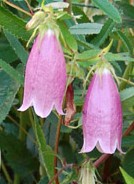 Spotted bellflower is a herbaceous perennial native to Japan and Siberia where it grows in lowlands on disturbed soil such as roadsides and fields. The light green leaves are triangular and serrated. They form an attractive mound which sends up stems of large drooping bells from June to July. The flowers are white, rose, pink, or violet and have red spots and hairs inside. Although many bellflowers are well behaved garden plants, spotted bellflower spreads by stolons and can be invasive. Its vigorous nature can be forgiven, however, because it is one of the few bellflowers that grow well in USDA zone 7 and warmer. Good container plant and cut flower.
Spotted bellflower is a herbaceous perennial native to Japan and Siberia where it grows in lowlands on disturbed soil such as roadsides and fields. The light green leaves are triangular and serrated. They form an attractive mound which sends up stems of large drooping bells from June to July. The flowers are white, rose, pink, or violet and have red spots and hairs inside. Although many bellflowers are well behaved garden plants, spotted bellflower spreads by stolons and can be invasive. Its vigorous nature can be forgiven, however, because it is one of the few bellflowers that grow well in USDA zone 7 and warmer. Good container plant and cut flower.
Type: Herbaceous perennial
Bloom: Dropping bell-shaped flowers in white, rose, pink and violet from June to July
Size: 12-24” H x 12-20” W
Light: Full sun to partial shade
Soil: Fertile, moderately moist, well-drained
Hardiness: Zones 5-8
Care: Pinch of tips when plants are 6 inches tall to reduce the need for staking; deadhead to prolong bloom time
Pests and Diseases: Slugs and snails; powdery mildew
Propagation: Seed, division in spring or fall, basal cuttings in spring
Companion plants: Crainsbill geraniums, phlox, balloon flower, daylily
Oustanding Selections:
Cherry Bells’ (Deep pink flowers)
‘Pantaloons’ (Rosy pink, “hose in hose” flowers)
‘Plum Wine’ (Light pink flowers)